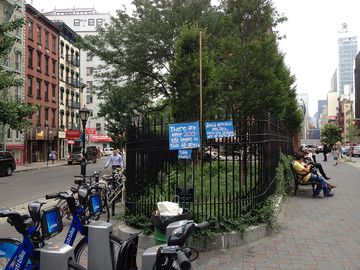

Although there is nothing remarkable about this little triangular park and the buildings that surround it, the square is named after a very important Italian American and today serves as the northwest boundary of the Little Italy neighborhood.
Joseph Petrosino was a New York City police officer who was famous for his tireless battles against organized crime and today is still highly regarded for his techniques.
He was born in 1860 in a little village of the Campania Region in southern Italy. When he was still a boy he immigrated to New York with his cousin and first lived with his grandfather. After their grandfather's death the boys were adopted by the Orphans Court Judge, who would later open many doors in Joseph's career.
At the age of 23 Petrosino entered the New York Police Department, becoming the first Italian native to serve in the department. Since he was the only one in the police force to speak Italian, he was perfect for handling cases in the neighborhood that would later be called Little Italy. His abilities were noticed by New York City police commissioner Theodore Roosevelt, who would later become America's 26th president, and a the age of 35 Petrosino was promoted to the post of detective sergeant, a role that put him in charge of the Homicide Division. About ten years later he was made Lieutenant at the head of the Italian Squad, a special unit of Italian-American detectives working to round up the local mafia.
Petrosino's first major case was the Black Hand affair. More than a criminal organization, the Black Hand was an extortion method that gangsters from various affiliations participated in. When world-famous Italian tenor Enrico Caruso was performing at the Metropolitan Opera House, the gangsters tried to extort money from him, threatening him with his life. Caruso turned to the police and Petrosino, with the singer's assistance, was able to apprehend the blackmailers.
In 1901 Petrosino also discovered the presence of an Italian-based anarchist organization that was planning the assassination of President William McKinley. The organization had already been responsible for the assassination of King Umberto I of Italy a year earlier. Petrosino warned the presidential staff through Vice President Theodore Roosevelt, but McKinley did not take the threat seriously. A couple of weeks later McKinley was assassinated during his trip to Buffalo in upstate New York.
In 1909 Petrosino travelled to Sicily to gather information on Italian-Americans who had criminal records in Italy with the aim of deporting them out of the United States. It was a top secret operation, but someone had leaked the information to a journalist, who wrote an article about it. Upon his arrival in Sicily, Petrosino was deceived into thinking he would be meeting an informer. But when he arrived at the meeting, he was gunned down by a couple of hitmen. Although the exact identity of the gunmen has not been established, it is thought that Petrosino's murder was ordered by Vito Cascioferro, a mob boss who had been deported from New York a few years earlier thanks to the arrest organized by Petrosino.
Joe Petrosino was given a hero's funeral in the Old St. Patrick's Cathedral on Mulberry Street, the main street of the Italian neighborhood in that period, with a procession that consisted of over 200,000 people. He was buried in the Calvary Cemetery in the borough of Queens.